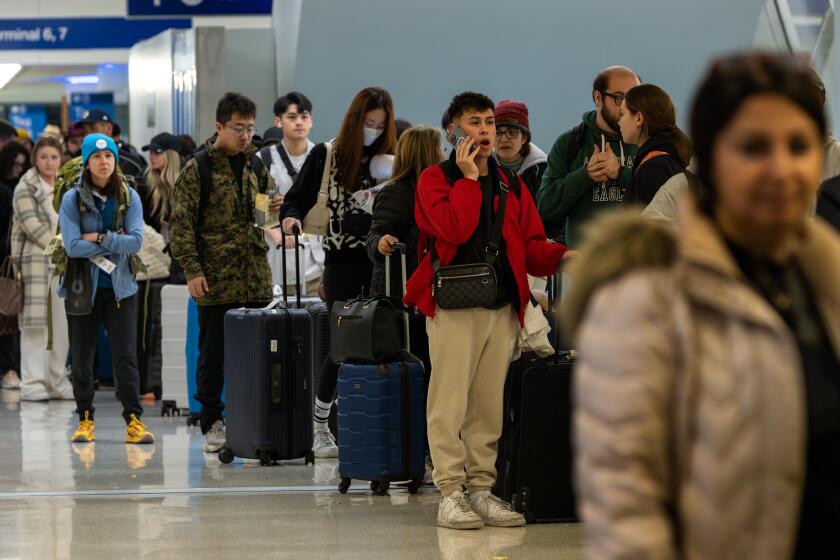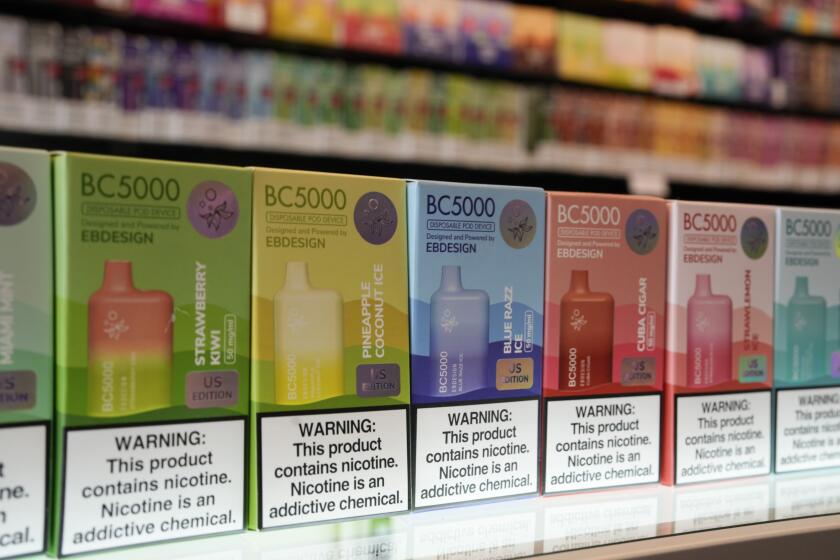Illegal e-cigarettes are flooding the ports in Southern California and beyond

- Share via
Federal officials are seizing more shipments of unauthorized electronic cigarettes at U.S. ports, including a major bust at Los Angeles International Airport.
But thousands of new flavored products continue pouring into the country from China, according to government and industry data reviewed by the Associated Press.
The figures underscore the chaotic state of the nation’s $7-billion vaping market and raise questions about how the U.S. government can stop the flow of fruit-flavored disposable e-cigarettes used by 1 in 10 American teens and adolescents.
More than 11,500 unique vaping products are being sold in U.S. stores, up 27% from 9,000 products in June, according to tightly held industry data from analytics firm Circana.
“FDA whacks one product and then the manufacturers get around it and the kids get around it,” said Bonnie Halpern-Felsher, a Stanford University psychologist who develops anti-vaping educational materials. “It’s too easy to change your product a little bit and just relaunch it.”
COVID-19, flu and respiratory syncytial virus (RSV) cases are all on the rise or at a high level in California and elsewhere.
Halpern-Felsher says she is “constantly” updating her curriculum to keep pace with new vaping brands and trends.
Nearly all the new products are disposable e-cigarettes, according to sales data gathered from gas stations, convenience stores and other shops. The products generated $3.2 billion in the first 11 months of this year.
The FDA has authorized a handful of e-cigarettes for adult smokers and is still reviewing products from several major companies, including Juul. Regulators consider nearly all other e-cigarettes to be illegal.
“Those committing illegal acts don’t advertise their crimes, and those trying to import illegal tobacco products into the United States are no different,” said FDA’s tobacco director, Brian King, in a written response to AP questions. “The FDA and our federal partners are using tools, like import alerts, to stop these illegal tobacco products at the border and to deter countless others.”
The rise in e-cigarettes sold continues despite a record number of products detained.
An FDA database shows officials “refused” entry to 148 containers or pallets of “tobacco” goods last month, consisting almost entirely of vaping products from China. Refused imports are typically destroyed.
The owner of the smoke shop came out from the back of the store, thinking the car crash was part of a robbery scheme. Instead, it was a driver who was later arrested on suspicion of driving under the influence.
Through the end of November, U.S. officials had refused 374 such shipments this year, more than double the 118 refused in 2022.
In December, the FDA and U.S. Customs and Border Protection revealed that agents had seized more than 1.4 million illegal e-cigarettes, valued at $18 million, at Los Angeles International Airport.
The shipments seized were from overseas manufacturers, including the Chinese company behind Elf Bar, a line of fruity disposable vapes that has become the top brand among American teens, officials said.
This year’s items included $400,000 worth of Esco Bars, a disposable brand placed on a list of banned imports in May. The agency’s posted data are often preliminary because it takes time to finalize refusals.
But recent history shows how easily companies can maneuver around import bans.
In July 2022, the FDA barred dozens of e-cigarettes from Chinese manufacturer Fume, including flavors Pineapple Ice and Blue Razz.
In a survey, 10% of high school students said they had used electronic cigarettes in the previous month, down from 14% last year.
Fume sales dipped after the ban, but the company launched a slew of new products, posting $42 million in U.S. sales in the third quarter of 2023, the data show. Roughly 98% of sales came from products not on the FDA’s “red list” of products that can be detained.
Industry shipping tactics are also challenging the usefulness of import restrictions.
The illegal vapes found at LAX were mislabeled as shoes, toys and other items — not e-cigarettes — requiring officials to individually open and verify the contents of more than two dozen containers.
Circana, formerly IRI, restricts access to its data, which it sells to companies and researchers. A person not authorized to share it gave the AP access on condition of anonymity.
The FDA has no schedule for updating its import lists but said it is “closely monitoring” instances in which companies try to avoid detection.
“The FDA has a variety of tools at our disposal to take action against these tactics,” FDA’s King said.
The agency has limited powers to penalize foreign companies. Instead, regulators have sent hundreds of warning letters to U.S. stores selling their products, but those are not legally binding.
U.S. adults are smoking less. Cigarette smoking dropped to another new all-time low last year, but e-cigarette use rose, to about 1 in 17 adults.
Even as the FDA attempts to work with customs officials, it is struggling to complete a years-long review of applications submitted by manufacturers hoping to market their products to adults.
The few tobacco-flavored products currently authorized by the FDA are not popular. Their combined sales were just $174 million, or 2.4% of the vaping marketplace this year, according to Circana.
“Nobody wants them,” said Marc Silas, owner of 906 Vapor, a shop in Michigan. “If people wanted them, they’d be on the shelves, and they’re not.”
Deeply frustrated with the pace of FDA’s review, public health groups have successfully sued the agency to speed up the process. The agency aimed to complete all major outstanding applications this year, but it recently said the process would stretch into next year.
The delays have raised questions about the viability of the the current regulatory framework for e-cigarettes.
“FDA is trying to operate with an old model when the whole environment has changed,” said Scott Ballin, a health policy consultant who previously worked for the American Heart Assn. “They have this long line of products that have to be reviewed one by one and now they’re in a giant hole.”
One alternative approach would be to make decisions about entire classes of e-cigarettes, rather than individual products.
The idea initially came from small vaping manufacturers that did not have the money to conduct the large studies typical of FDA applications. Public health advocates concerned about the persistence of underage vaping have embraced it.
Halpern-Felsher, of Stanford University, is among those urging the FDA to ban all flavored disposable e-cigarettes, the products used by most of the 2 million underage teens who vape.
“If we continue down this path that we’re on, we’re just going to have new and continuing generations of young people addicted to nicotine,” she said.
___
The Associated Press Health and Science Department receives support from the Howard Hughes Medical Institute’s Science and Educational Media Group. The AP is solely responsible for all content.
More to Read
Inside the business of entertainment
The Wide Shot brings you news, analysis and insights on everything from streaming wars to production — and what it all means for the future.
You may occasionally receive promotional content from the Los Angeles Times.














